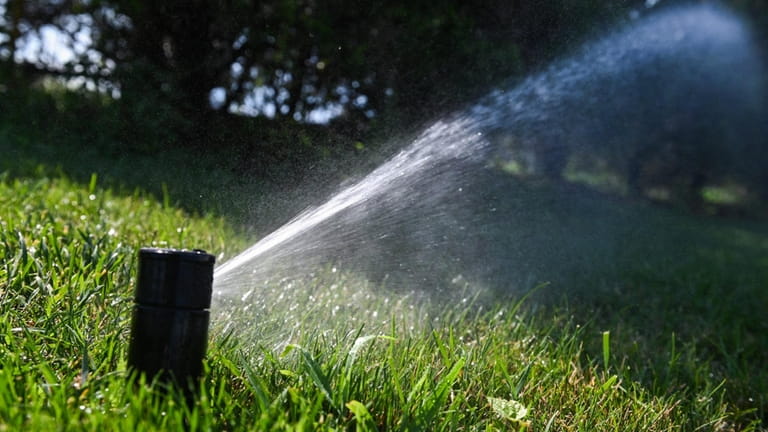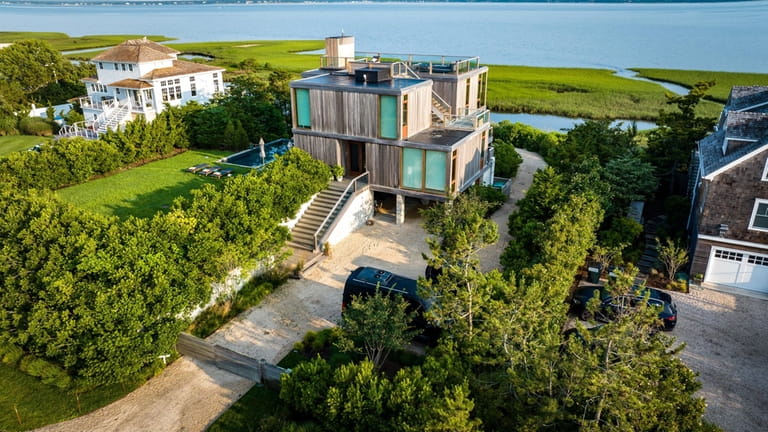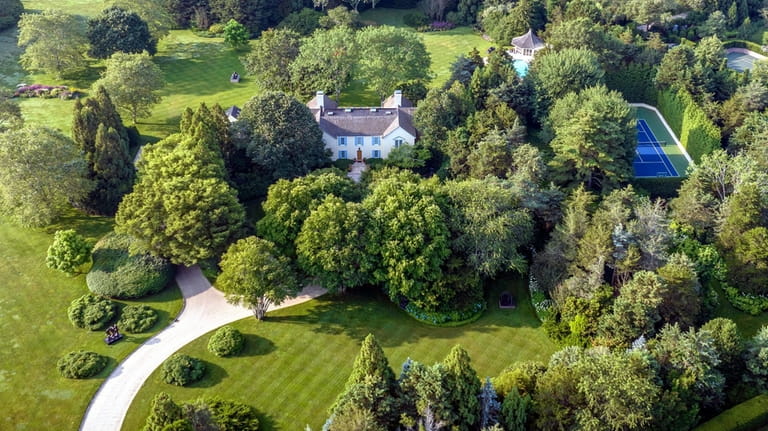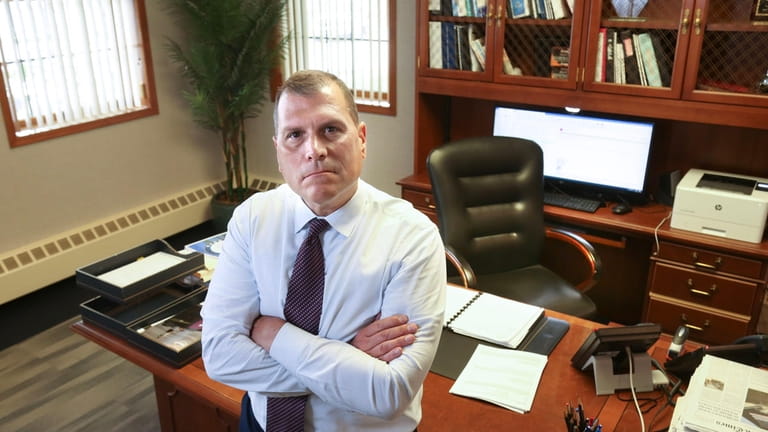Hamptons' 'Billionaire Lane' among top water users on Long Island
The epicenter of the escalating battle to curb water consumption can be found on Long Island’s East End. There, 70% of the water usage has been for lawn watering and irrigation, Suffolk County Water Authority officials said, depleting water tanks overnight and raising concerns about whether there would be enough water to fight fires or keep critical care facilities running.
All but one of the top 15 highest water users in Suffolk County last year were on the South Fork, according to water records Newsday obtained under a Freedom of Information Law request.
Records also show nine of the top residential water users last year were in Southampton Village, where last summer's water emergency started. Five of the top 11 users were located along Meadow Lane, on a street nicknamed Billionaire Lane.
Suffolk began to experience drought levels earlier this summer, according to the U.S. Drought Monitor, and current levels are listed as “abnormally dry.”
Water officials have urged towns and villages on the East End to adopt ordinances codifying the watering policy to bolster its initiative. They've also asked property owners to eliminate midday irrigation. But municipalities have not done so, and the agency has no enforcement powers.
East End town and village officials expressed interest in spreading the water authority's conservation message, but have not yet adopted an ordinance.
Earlier this year, then-Southampton Village Mayor Jesse Warren introduced the water agency's request for an odd/even watering ordinance, but a brief discussion among board members didn't lead to any action.
“If it becomes more drastic a situation, then we can step it up and consider other measures,” Southampton Town Supervisor Jay Schneiderman said.
One measure mandates that residents not irrigate between 10 a.m. and 4 p.m., since most of the water spread during that time evaporates. The authority also increased its rebate program, allowing customers to earn up to $250 per account — instead of $50 — by using water-saving devices such as a rain sensor, pool cover or smart irrigation device.
Two homes in the Town of Southampton ranked as the county’s top water users for 2022, with one using 14.3 million gallons and another using 10.4 million gallons. That consumption compares with an average customer use of 150,000 gallons of water a year, according to the Suffolk County Water Authority.
In East Hampton, Town Supervisor Peter Van Scoyoc said town officials are “very supportive” of the water agency's conservation message, but “kind of reluctant” to codify any measures to enforce it, saying the town has "enough challenges resource-wise in the summertime."
Even in the small village of North Haven, where officials invited representatives from the Suffolk County Water Authority to present conservation plans at a meeting, Mayor Chris Fiore urged residents to follow the agency's recommendations, but the board did not consider an ordinance.
Officials with the Hampton Bays Water District tried earlier this year to get customers to voluntarily stop watering their lawns overnight and to follow odd/even watering due to “dramatic increases in water usage." Superintendent James Kappers said total gallons pumped per day climbs from 1 million to 2 million between January and April to 5 million to 9 million between May and September. The district's storage tanks are "nearly depleted" during the high demand time when residents run irrigation in early morning hours, he added.
In the Town of Riverhead, which has its own water district, an attempt to codify an odd/even watering policy earlier this year stalled after homeowners complained the measures were too stringent and that proposed fines could unjustly impact them.
“We just don’t have the resources, nor does anybody, to become the water police,” said Frank Mancini, the water district superintendent who introduced the plan.
Southold Town recently restored a water conservation committee that has proposed an odd/even policy, Supervisor Scott Russell said. He said the town board “supports” the proposal, but so far hasn't taken action to codify it.
A Nassau County ordinance that dates to 1987 requires residents to follow the odd/even system as well as a ban on lawn irrigation from 10 a.m. to 4 p.m.
Daniel Dubois, the director of external affairs for the Suffolk County Water Authority, said the agency hasn't yet had discussions with the Suffolk legislature about proposing an ordinance.
While properties within certain portions of East End towns rely on private wells for water, Shelter Island almost exclusively uses well water.
Joe Finora, Shelter Island’s town engineer, said Island officials closely monitor monthly rain and track aquifer levels through monitoring wells.
The Island is currently under a water advisory level of “guarded,” which asks residents to voluntarily reduce water usage.
“We’re approaching drought conditions earlier than we ever had before,” he said.
As global temperatures continue to rise, experts predict warmer, drier summers could lead to more consistent drought conditions. A February report from Moody’s Analytics highlighted Long Island’s elevated risk for water stress because of the region’s sole source aquifer.
“On Long Island, we take water for granted and inadvertently we end up wasting water,” said Adrienne Esposito, executive director of the nonprofit Citizens Campaign for the Environment. “There absolutely needs to be a proactive campaign to get people to change their habits to reduce water consumption.”
The residential properties that used the most water in 2022 were clustered in the Hamptons. Data that Newsday obtained from the Suffolk County Water Authority showed 14 of the top 15 highest users were in the Hamptons. One home on the list in Mastic was an anomaly due to a known leak, according to the agency.
The highest user, at 1710 Meadow Lane in Southampton Village, consumed 14.3 million gallons of water in 2022. That home, listed under the name Ickenham Limited, used nearly 4 million gallons more than any other in the county.
The next-highest residential user, at 7 Fairfield Pond in Sagaponack, listed under Samudra Farms LLC, consumed 10.4 million gallons, according to the agency. The 10,000-square-foot oceanfront home set on 3 acres sold for $50 million last year, Newsday previously reported.
Identities of the homeowners are shielded through the LLCs.
Each home in the top 15 used more than 4.7 million gallons of water in 2022, according to data obtained from the water authority.
A home at 1431 Meadow Lane in Southampton Village that belongs to Joann Goldsman, the wife of screenwriter Akiva Goldsman, was listed as third on the 2022 water use list. A representative for Goldsman, whose home used 8.9 million gallons of water last year, didn't return a request for comment.
A Southampton Village estate at 616 Ox Pasture Rd. was the fourth-highest user, consuming 7.6 million gallons. The estate owners, listed as 616 Oxpasture LLC, couldn't be reached.
Business owner Jonathan M. Tisch, whose Bridgehampton estate at 659 Ocean Rd. was fifth on the residential water users list — consuming 7.5 million gallons — didn't respond to an inquiry.
Suffolk County Water Authority CEO Jeffrey Szabo said he has tried to open a dialogue with the worst offenders.
“We need to speak to them and we need to work with them so that they know the stress that they cause on the system,” he said.
In 2019, the agency implemented a tiered-rate system to encourage water conservation by charging more for customers who exceed 78,540 gallons per quarter — now about 44% more than the standard water consumption rate.
Mancini, who worked as a hydrogeologist for the water authority before his Riverhead water district supervisor job, acknowledged the wealthiest homeowners “don’t care how much it costs.”
He recalled driving across the South Fork a decade ago during overnight hours to monitor water consumption and said it would be “like a rainforest" with roads flooded from irrigation systems.
"And there’s sprinkler heads firing off everywhere," Mancini said.
Szabo said the authority doesn’t expect change to happen overnight.
“We’re realistic and know habits change over time,” he said. “It’s going to take some years to educate and to continue to have the dialogue with our users before we see real significant change.”
Earlier this year, the agency held a seminar with the Irrigation Association of New York, an organization of contractors representing the state’s irrigation industry.
Szabo said the goal was to educate association members on water conservation, particularly on the East End.
Mike Dwyer, an association board member, said in an interview that web-enabled smart devices that can monitor weather through the internet are a key tool for reducing water usage.
A homeowner may see it’s hot and dry out and increase watering through a conventional controller, he said, and then forget to change it back to normal levels.
“You never turn it back down so you just keep amplifying demand, demand, demand when it’s not necessary,” Dwyer said.
The irrigation specialist added that there can be pressure on landscapers who work at large Hamptons homes to maintain green lawns. But Dwyer said the goal is to demonstrate that with "a little bit more due diligence" conservation goals can be met and End End clients still can be happy.
"The simple answer is, they want it green," he said.
The epicenter of the escalating battle to curb water consumption can be found on Long Island’s East End. There, 70% of the water usage has been for lawn watering and irrigation, Suffolk County Water Authority officials said, depleting water tanks overnight and raising concerns about whether there would be enough water to fight fires or keep critical care facilities running.
All but one of the top 15 highest water users in Suffolk County last year were on the South Fork, according to water records Newsday obtained under a Freedom of Information Law request.
Records also show nine of the top residential water users last year were in Southampton Village, where last summer's water emergency started. Five of the top 11 users were located along Meadow Lane, on a street nicknamed Billionaire Lane.
Suffolk began to experience drought levels earlier this summer, according to the U.S. Drought Monitor, and current levels are listed as “abnormally dry.”
WHAT TO KNOW
- About 70% of the 70 billion gallons of drinking water pumped all year by the Suffolk County Water Authority is used by irrigation systems.
- To promote conservation, the Suffolk County Water Authority requires customers to only irrigate on odd or even days corresponding to home address.
- The agency has no enforcement power and has pushed East End municipalities to pass local ordinances to enforce odd/even watering.
Water officials have urged towns and villages on the East End to adopt ordinances codifying the watering policy to bolster its initiative. They've also asked property owners to eliminate midday irrigation. But municipalities have not done so, and the agency has no enforcement powers.
Water conservation urged
East End town and village officials expressed interest in spreading the water authority's conservation message, but have not yet adopted an ordinance.
Earlier this year, then-Southampton Village Mayor Jesse Warren introduced the water agency's request for an odd/even watering ordinance, but a brief discussion among board members didn't lead to any action.
“If it becomes more drastic a situation, then we can step it up and consider other measures,” Southampton Town Supervisor Jay Schneiderman said.
One measure mandates that residents not irrigate between 10 a.m. and 4 p.m., since most of the water spread during that time evaporates. The authority also increased its rebate program, allowing customers to earn up to $250 per account — instead of $50 — by using water-saving devices such as a rain sensor, pool cover or smart irrigation device.
Two homes in the Town of Southampton ranked as the county’s top water users for 2022, with one using 14.3 million gallons and another using 10.4 million gallons. That consumption compares with an average customer use of 150,000 gallons of water a year, according to the Suffolk County Water Authority.

Sprinkler action in Suffolk County, where water authority officials have asked customers to adopt conservation measures but have no enforcement power. Credit: Newsday/Steve Pfost
In East Hampton, Town Supervisor Peter Van Scoyoc said town officials are “very supportive” of the water agency's conservation message, but “kind of reluctant” to codify any measures to enforce it, saying the town has "enough challenges resource-wise in the summertime."
Even in the small village of North Haven, where officials invited representatives from the Suffolk County Water Authority to present conservation plans at a meeting, Mayor Chris Fiore urged residents to follow the agency's recommendations, but the board did not consider an ordinance.
Officials with the Hampton Bays Water District tried earlier this year to get customers to voluntarily stop watering their lawns overnight and to follow odd/even watering due to “dramatic increases in water usage." Superintendent James Kappers said total gallons pumped per day climbs from 1 million to 2 million between January and April to 5 million to 9 million between May and September. The district's storage tanks are "nearly depleted" during the high demand time when residents run irrigation in early morning hours, he added.
In the Town of Riverhead, which has its own water district, an attempt to codify an odd/even watering policy earlier this year stalled after homeowners complained the measures were too stringent and that proposed fines could unjustly impact them.
“We just don’t have the resources, nor does anybody, to become the water police,” said Frank Mancini, the water district superintendent who introduced the plan.
Southold Town recently restored a water conservation committee that has proposed an odd/even policy, Supervisor Scott Russell said. He said the town board “supports” the proposal, but so far hasn't taken action to codify it.
A Nassau County ordinance that dates to 1987 requires residents to follow the odd/even system as well as a ban on lawn irrigation from 10 a.m. to 4 p.m.
Daniel Dubois, the director of external affairs for the Suffolk County Water Authority, said the agency hasn't yet had discussions with the Suffolk legislature about proposing an ordinance.
While properties within certain portions of East End towns rely on private wells for water, Shelter Island almost exclusively uses well water.
Joe Finora, Shelter Island’s town engineer, said Island officials closely monitor monthly rain and track aquifer levels through monitoring wells.
The Island is currently under a water advisory level of “guarded,” which asks residents to voluntarily reduce water usage.
“We’re approaching drought conditions earlier than we ever had before,” he said.
As global temperatures continue to rise, experts predict warmer, drier summers could lead to more consistent drought conditions. A February report from Moody’s Analytics highlighted Long Island’s elevated risk for water stress because of the region’s sole source aquifer.
“On Long Island, we take water for granted and inadvertently we end up wasting water,” said Adrienne Esposito, executive director of the nonprofit Citizens Campaign for the Environment. “There absolutely needs to be a proactive campaign to get people to change their habits to reduce water consumption.”
Hamptons homes biggest water consumers
The residential properties that used the most water in 2022 were clustered in the Hamptons. Data that Newsday obtained from the Suffolk County Water Authority showed 14 of the top 15 highest users were in the Hamptons. One home on the list in Mastic was an anomaly due to a known leak, according to the agency.
The highest user, at 1710 Meadow Lane in Southampton Village, consumed 14.3 million gallons of water in 2022. That home, listed under the name Ickenham Limited, used nearly 4 million gallons more than any other in the county.
The next-highest residential user, at 7 Fairfield Pond in Sagaponack, listed under Samudra Farms LLC, consumed 10.4 million gallons, according to the agency. The 10,000-square-foot oceanfront home set on 3 acres sold for $50 million last year, Newsday previously reported.
Identities of the homeowners are shielded through the LLCs.

Records show this home at 1431 Meadow Lane in Southampton Village was the home with the third highest water consumption rate in Suffolk County in 2022, using 8.9 million gallons.
Credit: Newsday/J. Conrad Williams Jr.
Each home in the top 15 used more than 4.7 million gallons of water in 2022, according to data obtained from the water authority.
A home at 1431 Meadow Lane in Southampton Village that belongs to Joann Goldsman, the wife of screenwriter Akiva Goldsman, was listed as third on the 2022 water use list. A representative for Goldsman, whose home used 8.9 million gallons of water last year, didn't return a request for comment.
A Southampton Village estate at 616 Ox Pasture Rd. was the fourth-highest user, consuming 7.6 million gallons. The estate owners, listed as 616 Oxpasture LLC, couldn't be reached.

Records show this home at 616 Ox Pasture Rd. in Southampton Village was the fourth highest residential water user in Suffolk County in 2022, consuming 7.6 million gallons. Credit: Newsday/J. Conrad Williams Jr.
Business owner Jonathan M. Tisch, whose Bridgehampton estate at 659 Ocean Rd. was fifth on the residential water users list — consuming 7.5 million gallons — didn't respond to an inquiry.
'Sprinkler heads firing off everywhere'
Suffolk County Water Authority CEO Jeffrey Szabo said he has tried to open a dialogue with the worst offenders.
“We need to speak to them and we need to work with them so that they know the stress that they cause on the system,” he said.
In 2019, the agency implemented a tiered-rate system to encourage water conservation by charging more for customers who exceed 78,540 gallons per quarter — now about 44% more than the standard water consumption rate.

Suffolk County Water Authority CEO Jeffrey Szabo, shown in June, said he has tried to open a dialogue with some of the worst water conservation offenders. Credit: Newsday/John Paraskevas
Mancini, who worked as a hydrogeologist for the water authority before his Riverhead water district supervisor job, acknowledged the wealthiest homeowners “don’t care how much it costs.”
He recalled driving across the South Fork a decade ago during overnight hours to monitor water consumption and said it would be “like a rainforest" with roads flooded from irrigation systems.
"And there’s sprinkler heads firing off everywhere," Mancini said.
Szabo said the authority doesn’t expect change to happen overnight.
“We’re realistic and know habits change over time,” he said. “It’s going to take some years to educate and to continue to have the dialogue with our users before we see real significant change.”
Earlier this year, the agency held a seminar with the Irrigation Association of New York, an organization of contractors representing the state’s irrigation industry.
Szabo said the goal was to educate association members on water conservation, particularly on the East End.
Mike Dwyer, an association board member, said in an interview that web-enabled smart devices that can monitor weather through the internet are a key tool for reducing water usage.
A homeowner may see it’s hot and dry out and increase watering through a conventional controller, he said, and then forget to change it back to normal levels.
“You never turn it back down so you just keep amplifying demand, demand, demand when it’s not necessary,” Dwyer said.
The irrigation specialist added that there can be pressure on landscapers who work at large Hamptons homes to maintain green lawns. But Dwyer said the goal is to demonstrate that with "a little bit more due diligence" conservation goals can be met and End End clients still can be happy.
"The simple answer is, they want it green," he said.

